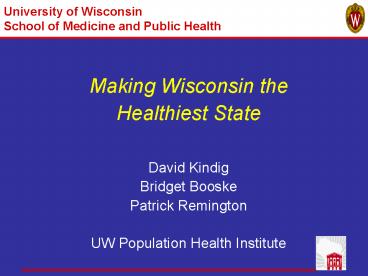Making Wisconsin the - PowerPoint PPT Presentation
1 / 30
Title:
Making Wisconsin the
Description:
Making Wisconsin the. Healthiest State. David Kindig ... Wisconsin's health overall is good (not perfect) But the distribution of health is not fair, by: ... – PowerPoint PPT presentation
Number of Views:43
Avg rating:3.0/5.0
Title: Making Wisconsin the
1
University of Wisconsin School of Medicine and
Public Health
- Making Wisconsin the
- Healthiest State
- David Kindig
- Bridget Booske
- Patrick Remington
- UW Population Health Institute
2
Purpose
- Review progress to date
- Get feedback and advice
- Ultimately, provide a resource for the state and
for communities
3
Three Questions
- How healthy are we?
- What are the drivers of health?
- What works?
4
How healthy are we?
5
How healthy are we?
How good?
How fair?
6
(No Transcript)
7
Wisconsin Working-Age Adult Mortality Rates (Ages
25-64, rates per 100,000 population)
Whites (279)
Rural (319)
Non-urban (275)
Men (367)
Suburban (247)
Women (225)
Milwaukee County (424)
Some college (212)
High school or less (459)
College graduates (188)
Native Americans (592)
African Americans (624)
Asians (170)
Worst state Mississippi (519)
Wisconsin (296)
Best state Minnesota (257)
8
Wisconsin Working-Age Adult Mortality Rates (Ages
25-64, rates per 100,000 population)
Whites (279)
Rural (319)
Non-urban (275)
Men (367)
Suburban (247)
Women (225)
Milwaukee County (424)
Some college (212)
High school or less (459)
(212)
College graduates (188)
Native Americans (592)
African Americans (624)
Asians (170)
Worst state Mississippi (519)
Best state Minnesota (257)
Wisconsin (296)
(206)
9
(No Transcript)
10
(No Transcript)
11
(No Transcript)
12
(No Transcript)
13
(No Transcript)
14
Mortality burden excess deaths
15
Annual excess deaths in Wisconsin Total deaths
4,782
1 dot 1 excess death
Dots are randomly placed within the county to
which they are assigned.
16
Annual excess deaths in Wisconsin Total deaths
4,782
1 dot 1 excess death
Dots are randomly placed within the county to
which they are assigned.
17
Major Finding
- Considerable excess mortality exists throughout
Wisconsin - The City of Milwaukee has about 28 of
Wisconsins excess mortality
18
How healthy are we?
- Wisconsins health overall is good (not perfect)
- But the distribution of health is not fair, by
- geography
- education
- race/ethnicity
19
What are the drivers of health?
20
(No Transcript)
21
What works?
22
What Works Policies and Programs to Improve
Wisconsins Health
- For each of the drivers of health, we identified
potential policies and programs that could
improve the driver - For each policy and program, we performed a wide
information scan to identify - Intended beneficial outcomes
- Level of implementation in Wisconsin other
states - Strength of evidence of effectiveness, and
- In some limited cases where information was
available the likely impact on disparities
23
What Works Policies and Programs to Improve
Wisconsins Health (cont)
- In addition, for each policy and program, we
- estimated potential population reach
- identified potential decision makers and
- attempted to determine likely impact on
disparities - We contacted content experts from academia,
government, and the community who reviewed and
commented on the evidence summaries - We developed a database containing over 360
potential policies and programs, with links to
references on evidence of effectiveness
24
What works?
25
Next Steps
- Add community and practice perspectives on
evidence move from what might work to what
really will work in practice - Identify gaps between research- and
practice-based evidence
26
(No Transcript)
27
Challenges for this process
- Top down versus bottom up evidence
- Evidence on reducing disparities is very
limitedwhich ones might increase disparities? - No discussion of feasibility, unintended
consequences, or multiple benefits - Much less information on cost-effectiveness
(/QALY) than effectiveness
28
Healthy Wisconsin 2020 Framework
Improved health across lifespan
Healthy, safe, and resilient communities,
families, and individuals
Reduced disease, injury, and disability
Improved health equity
29
Acknowledgments
University of Wisconsin School of Medicine and
Public Health
- Former Secretary, Helene Nelson
- Anna Graupner, and other graduate students
- The Department of Health Services
- The reviewers of the drafts of evidence tables
- Todays experts and facilitators
- The Wisconsin Partnership Program
30
Dialogue on Key Strategies
- Track A Improving our health behaviors
- Room E Physical activity, nutrition, and obesity
- Room F Alcohol use and addiction
- Track B Mix of prevention and treatment
- Room G Health care quality and costs
- Room H Public health improvement across sectors
- Track C Healthier social and economic climate
- Room I Children born healthy with a healthy
start - Room J Working together to improve rural health































